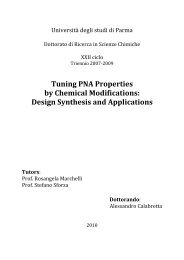Create successful ePaper yourself
Turn your PDF publications into a flip-book with our unique Google optimized e-Paper software.
defined as any substance, structure, or process that<br />
can be measured in the body or its products, and<br />
which influence or predict the incidence of outcome<br />
or disease. 5 Biomarkers of lung diseases can be<br />
developed on the basis of exhaled air and blood<br />
analyses.<br />
The analysis of exhaled air is feasible and noninvasive.<br />
6 Exhaled breath condensate (EBC) obtained<br />
by cooling exhaled air under conditions of spontaneous<br />
breathing is a promising biological fluid that<br />
could provide a real-time assessment of pulmonary<br />
pathobiology. It can be easily and noninvasively<br />
collected from patients of any age using portable<br />
devices in an outpatient setting or even at home.<br />
EBC is particularly suitable for the sequential and<br />
longitudinal sampling of the lower respiratory tract,<br />
and published data on inflammation mediators suggest<br />
that it reflects the abnormalities noted in bronchoscopic<br />
specimens. 7 Despite the enthusiasm of a<br />
few research groups, there is skepticism concerning<br />
the diagnostic and monitoring validity of EBC because<br />
of the analytical problems associated with<br />
measuring trace amounts of unstable and nonspecific<br />
mediators, which mainly relies on immunochemistry<br />
techniques that lack reference methods and materials,<br />
and are affected by their poor sensitivity, specificity,<br />
and selectivity. 8<br />
As EBC mainly consists of water that is practically<br />
free of potentially interfering solutes, it is an ideal<br />
biological fluid for elemental determinations based<br />
on relatively common techniques, such as electrothermal<br />
atomic absorption spectroscopy (ETAAS),<br />
or less frequently available reference instruments<br />
such as inductively coupled plasma-mass spectrometry<br />
(ICP-MS).<br />
The aim of this study was to investigate the<br />
elemental composition of EBC in order to identify<br />
*From the Laboratory of Industrial Toxicology (Dr. Mutti),<br />
Department of Clinical Medicine, Nephrology and Health Sciences,<br />
University of Parma, Parma, Italy; National Institute of<br />
Occupational Safety and Prevention (Drs. Corradi and Vettori,<br />
and Mr. Goldoni), Research Centre at the University of Parma,<br />
Parma, Italy; Unit of Toxicology (Dr. Bernard), Catholic University<br />
of Louvain, Brussels, Belgium; and Laboratory of Industrial<br />
Hygiene (Dr. Apostoli), Department of Experimental and Applied<br />
Medicine, University of Brescia, Brescia, Italy.<br />
This study was supported by National Heart, Blood, and Lung<br />
Institute grant R01 HL72323. The contents of this article are<br />
solely the responsibility of the authors, and do not necessarily<br />
represent the official views of the National Heart, Blood, and<br />
Lung Institute or the National Institutes of Health.<br />
Manuscript received August 14, 2005; revision accepted November<br />
4, 2005.<br />
Reproduction of this article is prohibited without written permission<br />
from the American College of Chest Physicians (www.chestjournal.<br />
org/misc/reprints.shtml).<br />
Correspondence to: Antonio Mutti, MD, Laboratory of Industrial<br />
Toxicology, Department of Clinical Medicine, Nephrology, and<br />
Health Sciences, University of Parma, Via Gramsci 14, 43100<br />
Parma, Italy; e-mail: antonio.mutti@unipr.it<br />
new biomarkers of exposure, or susceptibility, in<br />
COPD patients. The working hypothesis was that<br />
long-term exposure to tobacco smoke (which may<br />
cause the development of COPD) leads to an increased<br />
lung uptake of toxic metals that, because of<br />
their stability, can also be used as tracers of environmental<br />
pollution. Likewise, hard metals in occupationally<br />
exposed workers 9 and toxic metals (such as<br />
lead, cadmium, chromium, nickel, and aluminum)<br />
should provide a quantitative estimate of target<br />
tissue burden.<br />
EBC was also used to quantify essential elements<br />
as biomarkers of susceptibility, which have been<br />
defined as “indicators of an inherited or acquired<br />
limitation of an organism’s ability to respond to the<br />
challenge of exposure to a xenobiotic substance.” 5<br />
Individual detoxifying capacity modulates the lung<br />
response to inhaled pneumotoxic substances, and<br />
there is considerable variability in individual responses<br />
to toxic substances. A growing body of<br />
evidence indicates that many transition elements<br />
play important roles in biological processes by activating<br />
or inhibiting enzymatic reactions, by competing<br />
with other elements and metalloproteins for<br />
binding sites, or by affecting the permeability of cell<br />
membranes.<br />
The possible biomarkers of susceptibility were<br />
investigated bearing in mind that some transition<br />
elements play a fundamental role in the respiratory<br />
chain (iron), or are components of mitochondrial<br />
(manganese) or cytoplasmic (copper, zinc) superoxide<br />
dismutases (SODs), or glutathione peroxidase<br />
(selenium). Given their key roles in the generation<br />
and detoxification of reactive oxygen species, and the<br />
scavenging of free radicals, transition elements modulate<br />
the response to toxic substances, 10 thus possibly<br />
accounting for the limited proportion (15 to 20%) of<br />
smokers acquiring COPD. Biomarkers of susceptibility<br />
may be useful in identifying and counseling<br />
people at increased risk of disease when exposed to<br />
tobacco smoke or environmental pollutants.<br />
Finally, we analyzed serum pneumoproteins<br />
(Clara-cell secretory protein [CC16]), and three<br />
surfactant proteins (SPs), SP-A, SP-B, and SP-D,<br />
which were used as a complementary approach to<br />
develop biomarkers of effect suitable for the longterm<br />
monitoring of COPD patients. As these proteins<br />
are mainly (if not exclusively) secreted within<br />
the respiratory tract, their occurrence in the vascular<br />
compartment can only be explained by assuming<br />
their leakage from the lung into the bloodstream.<br />
Excluding changes in renal function, their serum<br />
concentrations can be expected to reflect their rate<br />
of synthesis and the permeability of the lung epithelium.<br />
11<br />
www.chestjournal.org CHEST / 129 /5/MAY, 2006 1289<br />
Downloaded from<br />
chestjournals.org on May 23, 2007<br />
Copyright © 2006 by American College of Chest Physicians
















